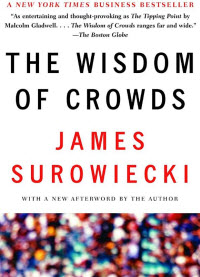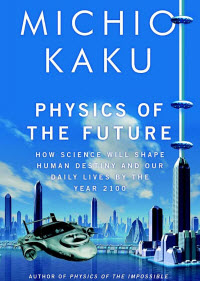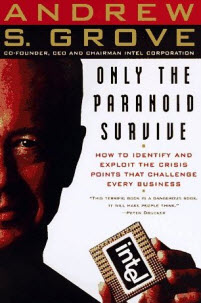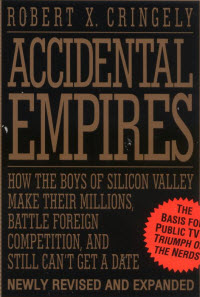 11. The Wisdom of Crowds: Why the Many Are Smarter Than the Few and How Collective Wisdom Shapes Business, Economies, Societies and Nations by James Surowiecki (2004). This is one of those big ideas that overturned conventional wisdom: mob rule is usually right. If you go to a county fair and guess the weight of an ox, the odds are that you’ll be wrong. But the average of the collective guesses of everybody will more than likely be right. The aggregation of information in groups often leads to predictions or decisions that are on the mark, whereas the predictions of informed individuals are often wrong. This newfound belief in crowds led to a number of crowdsourcing activities — prediction markets, Wikipedia, alternate reality games, or Betfair.
11. The Wisdom of Crowds: Why the Many Are Smarter Than the Few and How Collective Wisdom Shapes Business, Economies, Societies and Nations by James Surowiecki (2004). This is one of those big ideas that overturned conventional wisdom: mob rule is usually right. If you go to a county fair and guess the weight of an ox, the odds are that you’ll be wrong. But the average of the collective guesses of everybody will more than likely be right. The aggregation of information in groups often leads to predictions or decisions that are on the mark, whereas the predictions of informed individuals are often wrong. This newfound belief in crowds led to a number of crowdsourcing activities — prediction markets, Wikipedia, alternate reality games, or Betfair.
 12. The Physics of the Future: How Science Will Shape Human Destiny and Our Daily Lives by the Year 2100 by Michio Kaku (2011). See the future through the eyes of a physicist, who tours the world’s R&D labs to show us the technologies that will shape our lives in the year 2100. He takes an expansive view, including chapters on advanced gene therapy, nanobots, tricorders, artificial intelligence, microbiology, and jobs of the future. Kaku’s views are built on top of interviews with more than 300 top scientists. Even though the book is full of crazy predictions, it hasn’t become dated in any way, as is the problem with most books about the future. Sure, it’s still new. But Kaku is careful ground all of his predictions as logical extensions of the technologies we have today and the researchers that are looking at the future. I listen to this book on my iPhone while jogging and I inevitably come back inspired to write some kind of story when I return.
12. The Physics of the Future: How Science Will Shape Human Destiny and Our Daily Lives by the Year 2100 by Michio Kaku (2011). See the future through the eyes of a physicist, who tours the world’s R&D labs to show us the technologies that will shape our lives in the year 2100. He takes an expansive view, including chapters on advanced gene therapy, nanobots, tricorders, artificial intelligence, microbiology, and jobs of the future. Kaku’s views are built on top of interviews with more than 300 top scientists. Even though the book is full of crazy predictions, it hasn’t become dated in any way, as is the problem with most books about the future. Sure, it’s still new. But Kaku is careful ground all of his predictions as logical extensions of the technologies we have today and the researchers that are looking at the future. I listen to this book on my iPhone while jogging and I inevitably come back inspired to write some kind of story when I return.
 13. World War 3.0: Microsoft and its Enemies by Ken Auletta (2001). This book chronicles the great struggle between the government’s antitrust regulators and Microsoft over reining in the company’s monopolistic practices. Microsoft founder Bill Gates, government attorney David Boies and Judge Richard Posner come into sharp focus in this epic story. Auletta’s ability to gain access to the top titans of business and be a fly on the wall during their key moments is unmatched. The tale showed what happened when a hodge-podge of individuals stood up against the most powerful company in the tech industry and turned the tables on it. A moment that will make you squirm is when Craig Barrett, then the CEO of Intel, bore down hard on his loose-cannon technologist Steven McGeady, not to testify against Microsoft and Gates. McGeady stood his ground and testified.
13. World War 3.0: Microsoft and its Enemies by Ken Auletta (2001). This book chronicles the great struggle between the government’s antitrust regulators and Microsoft over reining in the company’s monopolistic practices. Microsoft founder Bill Gates, government attorney David Boies and Judge Richard Posner come into sharp focus in this epic story. Auletta’s ability to gain access to the top titans of business and be a fly on the wall during their key moments is unmatched. The tale showed what happened when a hodge-podge of individuals stood up against the most powerful company in the tech industry and turned the tables on it. A moment that will make you squirm is when Craig Barrett, then the CEO of Intel, bore down hard on his loose-cannon technologist Steven McGeady, not to testify against Microsoft and Gates. McGeady stood his ground and testified.
 14. Only the Paranoid Survive: How to Exploit the Crisis Points That Challenge Every Company by Andrew S. Grove (1996). Under the leadership of Andy Grove, Intel became the world’s largest chip maker with a virtual monopoly on PC microprocessors, the biggest chip business of them all in terms of dollars generated. Grove was ruthlessly efficient at managing his company through tough decisions. He tells the story of how the Japanese were attacking the memory chip business that Intel invented. Intel could no longer make money because the Japanese had dumped chips — sold them for below production costs — and improved their quality. So Grove and Intel co-founder Gordon Moore decided to do the unthinkable: exit the memory business. Instead, they chose to focus on microprocessors, and the rest is history. The book chronicles what Intel went through in 1994 when a mathematician discovered a small math bug in the company’s Pentium processor. The resulting $475 million write-off was one of the biggest of all time, but Intel rolled with the punches and survived its crisis, in no small part due to its paranoia. Grove’s approach to seeing the market change and getting ahead of it — what hockey star Wayne Gretzky called “skating to where the puck will be” — is a parable that any leader can adopt.
14. Only the Paranoid Survive: How to Exploit the Crisis Points That Challenge Every Company by Andrew S. Grove (1996). Under the leadership of Andy Grove, Intel became the world’s largest chip maker with a virtual monopoly on PC microprocessors, the biggest chip business of them all in terms of dollars generated. Grove was ruthlessly efficient at managing his company through tough decisions. He tells the story of how the Japanese were attacking the memory chip business that Intel invented. Intel could no longer make money because the Japanese had dumped chips — sold them for below production costs — and improved their quality. So Grove and Intel co-founder Gordon Moore decided to do the unthinkable: exit the memory business. Instead, they chose to focus on microprocessors, and the rest is history. The book chronicles what Intel went through in 1994 when a mathematician discovered a small math bug in the company’s Pentium processor. The resulting $475 million write-off was one of the biggest of all time, but Intel rolled with the punches and survived its crisis, in no small part due to its paranoia. Grove’s approach to seeing the market change and getting ahead of it — what hockey star Wayne Gretzky called “skating to where the puck will be” — is a parable that any leader can adopt.
 15. Accidental Empires: How the Boys of Silicon Make Their Millions, Battle Foreign Competition, and Still can’t Get a Date by Robert X. Cringely (1996). This irreverent book describes the rise of the tech industry personalities like Steve Jobs, Bill Gates, Mitch Kapor and their hacker roots. As the gossip columnist for Infoworld, Cringely was relatively early in drawing the connection between creativity and lunacy among the geeks of Silicon Valley. The book is a reminder that business empires are often built by accident, but they are only maintained by those who have truly brilliant insights. Does anyone remember Gary Kildall, the creator of the CP/M operating system? Kildall happened to be out flying when IBM approached him to license his software for the original IBM PC. So instead, IBM turned to Gates at Microsoft. The book tells these tales with a sense of humor and it looks at today’s big business lords in the days when they were nothing more than nerds.
15. Accidental Empires: How the Boys of Silicon Make Their Millions, Battle Foreign Competition, and Still can’t Get a Date by Robert X. Cringely (1996). This irreverent book describes the rise of the tech industry personalities like Steve Jobs, Bill Gates, Mitch Kapor and their hacker roots. As the gossip columnist for Infoworld, Cringely was relatively early in drawing the connection between creativity and lunacy among the geeks of Silicon Valley. The book is a reminder that business empires are often built by accident, but they are only maintained by those who have truly brilliant insights. Does anyone remember Gary Kildall, the creator of the CP/M operating system? Kildall happened to be out flying when IBM approached him to license his software for the original IBM PC. So instead, IBM turned to Gates at Microsoft. The book tells these tales with a sense of humor and it looks at today’s big business lords in the days when they were nothing more than nerds.
